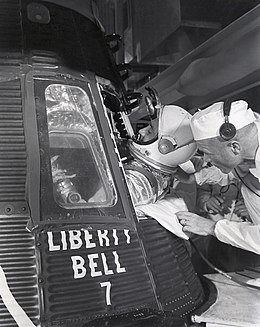
Back Mercury-Redstone 4 Afrikaans ميركوري-ريدستون 4 Arabic Мъркюри 4 Bulgarian Mercury-Redstone 4 Catalan Mercury-Redstone 4 Czech Mercury-Redstone 4 German Mercury Redstone 4 Spanish Mercury-Redstone 4 Finnish Mercury-Redstone 4 French Mercury-Redstone 4 Galician
 Astronaut Gus Grissom climbs into Liberty Bell 7 | |
| Mission type | Test flight |
|---|---|
| Operator | NASA |
| Mission duration | 15 minutes, 37 seconds[1] |
| Range | 262.50 nautical miles (486.15 km) |
| Apogee | 102.76 nautical miles (190.31 km) |
| Spacecraft properties | |
| Spacecraft | Mercury No.11 |
| Manufacturer | McDonnell Aircraft |
| Launch mass | 2,835 pounds (1,286 kg) |
| Crew | |
| Crew size | 1 |
| Members | |
| Callsign | Liberty Bell 7 |
| Start of mission | |
| Launch date | July 21, 1961, 12:20:36 UTC |
| Rocket | Redstone MRLV MR-8 |
| Launch site | Cape Canaveral LC-5 |
| End of mission | |
| Recovered by | USS Randolph |
| Landing date | July 21, 1961, 12:36:13 UTC |
| Landing site | North Atlantic Ocean 27°32′9″N 75°45′57″W / 27.53583°N 75.76583°W |
 Spacecraft name as painted on capsule side, with a "crack"  Virgil Ivan "Gus" Grissom Project Mercury Crewed missions | |
Mercury-Redstone 4 was the second United States human spaceflight, on July 21, 1961. The suborbital Project Mercury flight was launched with a Mercury-Redstone Launch Vehicle, MRLV-8. The spacecraft, Mercury capsule #11, was nicknamed Liberty Bell 7. It was piloted by astronaut Virgil "Gus" Grissom.
The spaceflight lasted 15 minutes 30 seconds, reached an altitude of more than 102.8 nautical miles (190.4 km), and flew 262.5 nautical miles (486.2 km) downrange, landing in the Atlantic Ocean. The flight went as expected until just after splashdown, when the hatch cover, designed to release explosively in the event of an emergency, accidentally blew. Grissom was at risk of drowning, but was recovered safely via a U.S. Navy helicopter. The spacecraft sank into the Atlantic and was not recovered until 1999.
© MMXXIII Rich X Search. We shall prevail. All rights reserved. Rich X Search